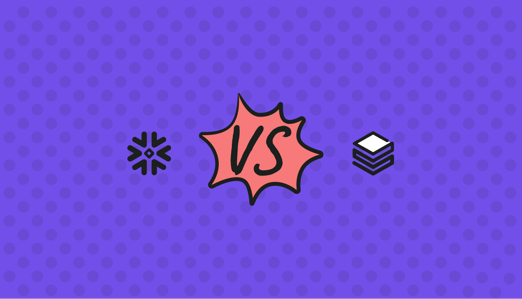
Snowflake and Databricks are two cloud-based data platforms that each have their own strengths and shortcomings.
In this article, we'll compare Snowflake and Databricks in terms of performance, use cases, and pricing.
Query Performance
When we talk about data, one of the first things that springs to mind is query performance.
Both Snowflake and Databricks are known for their excellent query performance but they have different approaches. Databricks is built on top of Apache Spark, which is a distributed computing network. You can use it with SQL queries, Python R, and Scala, and even run machine learning workflows with it.
Snowflake does things a bit differently. It separates compute and storage, using multi-cluster, shared data architecture to handle large workloads.
Overall, both platforms offer excellent query performance, but Snowflake is better suited for high concurrency workloads, while Databricks is more appropriate for data science workflows.
Architecture
Databricks is built on top of Apache Spark, which is a distributed computing framework that allows users to process large data sets in parallel across a cluster of computers. Spark provides a variety of APIs for data processing, including SQL, Python, R, and Scala.
Databricks also provides a number of features to simplify data processing and analysis, such as a built-in machine learning library and a collaborative workspace for data science teams.
Snowflake uses a unique cloud data platform that is designed to work with structured and semi-structured data. It separates storage from compute, which allows users to scale compute resources independently of storage resources. Snowflake also provides a variety of features for data warehousing, such as automatic scaling and data sharing.
Scalability
Both Databricks and Snowflake are designed to be highly scalable and can handle large volumes of data.
Snowflake is known for its ability to scale up and down automatically based on demand. Meaning, that you only pay for the compute resources you actually use, rather than having to provision and manage a fixed amount beforehand.
Databricks, on the other hand, can be configured to scale horizontally by adding more nodes to the cluster.
Pricing
Both Databricks and Snowflake offer pay-as-you-go pricing models based on usage.
Snowflake charges separately for storage and compute resources, which can be more cost-effective for users with large amounts of data that are not frequently accessed.
Databricks offers a unified pricing model that includes both storage and compute resources, which can be more convenient for users who need to manage both.
Use Cases
Databricks is ideal for data science, machine learning, and big data processing. It provides a variety of tools and features for data analysis, such as notebooks, libraries for machine learning and deep learning, and APIs for integration with other applications.
Databricks is also often used for data engineering tasks, such as data preparation and feature engineering, as well as for data science tasks, such as model development and deployment.
Snowflake is best suited for data warehousing and business intelligence applications. It provides a range of features for data warehousing, such as automatic scaling, data sharing, and data governance.
Snowflake is often used for tasks such as data integration, data warehousing, and data visualization, as well as for ad-hoc querying and reporting. Snowflake also integrates well with popular BI tools such as Tableau and Looker.
Final Thoughts
In conclusion, Databricks and Snowflake are two powerful platforms that serve different use cases.
Databricks is ideal for data science, machine learning, and big data processing, while Snowflake is best suited for data warehousing and business intelligence applications.
Snowflake is more suitable for standard data transformation and analysis, and for users familiar with SQL.Databricks is better suited for streaming, ML, AI, and data science workloads, thanks to its Spark engine, which supports multiple languages. Snowflake has been catching up on languages and has recently added support for Python, Java, and Scala.
Some argue that Snowflake is better for interactive queries because it optimizes storage during ingestion, and it excels in handling BI workloads, as well as creating reports and dashboards.
The right choice for your team will depend on your usage patterns, data volumes, workloads, and data strategies but Databricks — though harder to learn — has most of the features offered by Snowflake and then some.







